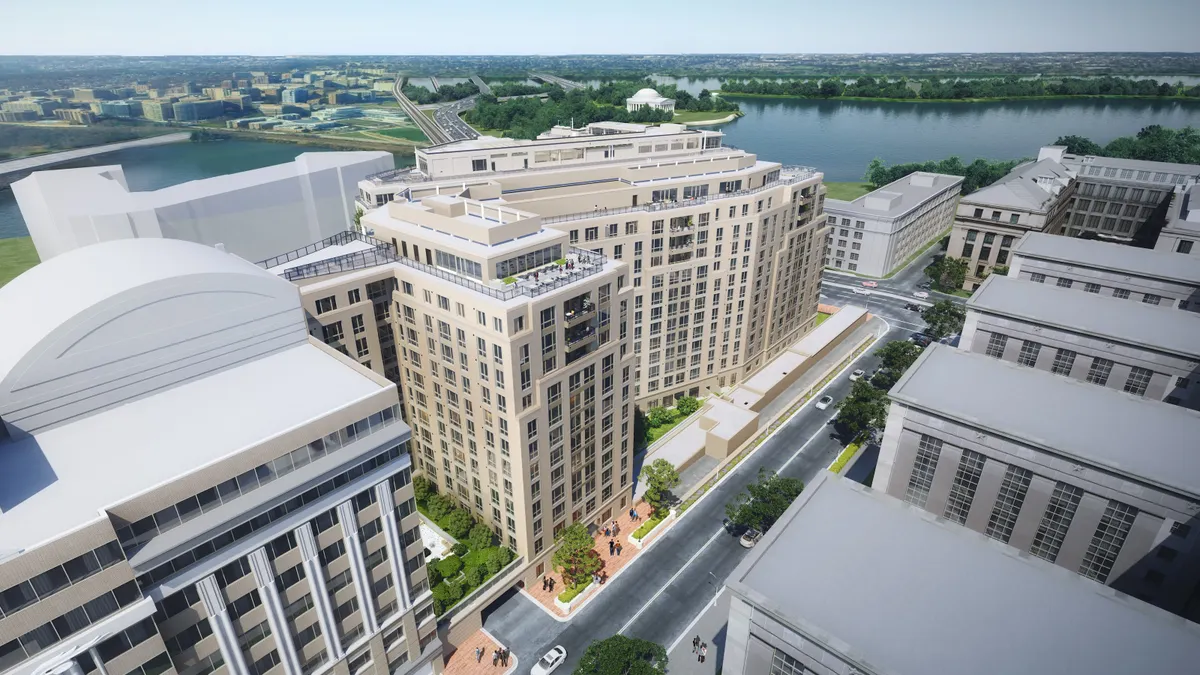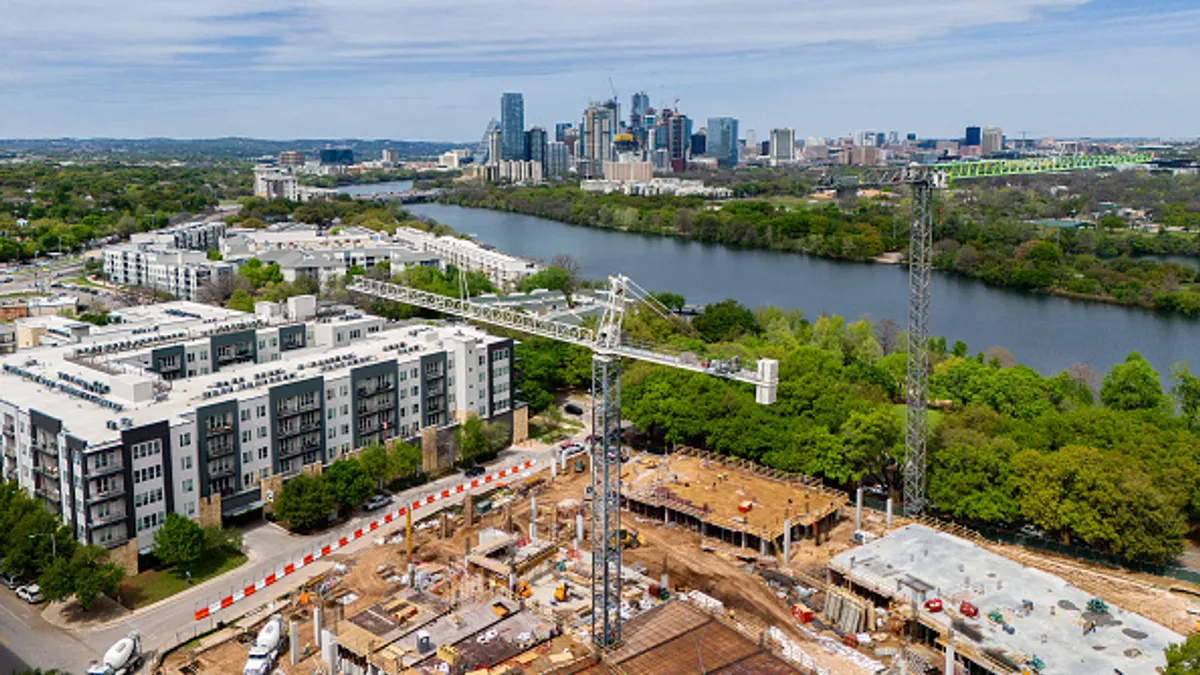This feature is a part of "The Dotted Line" series, which takes an in-depth look at the complex legal landscape of the construction industry. To view the entire series, click here.
Requests for proposals (RFPs) — they’re like supercharged invitations to bid, and contractor responses to them can form the blueprint for how the project will be run rather than just how much it will cost. So, when preparing a response to one of these documents, it’s important to know how RFPs relate to the contract, what will make a good impression on owners and how the experts handle proposals in response to these requests.
“The contract is largely tied to the terms of the RFP,” said attorney John-Patrick Curran, a partner at Sive Paget & Riesel in New York, which means contractors need to review them carefully and take the same level of care with their responses.
What is an RFP?
An RFP typically differs from a hard bid request in that the owner sometimes uses an RFP to get a level of detail from bidders that isn't addressed in other types of bid opportunities.
“The RFP process is generally utilized for projects where the design of the project may not be fully complete, so an owner is looking for construction partners to work together to develop an execution plan for the project," said Jorge Moros, vice president and director of business development at Plaza Construction in Miami.
To that end, an RFP, said Joshua Levy, partner at Husch Blackwell in Milwaukee, could include questions about:
- The contractor’s approach to project management.
- Who will make up the project team.
- What experience the company has with building information modeling (BIM).
- Ownership structure.
- Profiles of past similar projects.
- What kind of quality control plan the contractor will implement.
- Methods of cost and schedule control.
- The approach the company uses with governing authorities.
- A general description of the project's main features if the work will be performed under a design-build contract.
- Plans and specifications if the development has a design already.
And the list goes on. By the time a construction company answers every question in such a detailed RFP, it’s likely it will have a fully fleshed out plan of attack if it wins the project.
Of course, there are smaller projects that also use RFPs, Levy said, and those documents can be tailored to meet the owner’s needs.
The RFP might also contain a copy of the contract, Curran said, and submitting a proposal likely will commit the contractor to the terms of that contract. In these cases, it’s smart to have an attorney review the RFP just as one would any other construction contract.
Levy said he’d like to see more owners include contracts in RFPs, which he said would give all parties time to address questions about the contract well before it’s time to award the project.
That shouldn’t present a problem for contractors, Curran said, as long as they are given enough time to comb through that contract and voice objections prior to the bid deadline.
Other considerations
But contractors need to keep an eye out for other not-so-obvious sections of the RFP — ones that can potentially impact the contract that the winning bidder will be expected to sign. For instance, Curran said, the completed and submitted bid form could be deemed an offer, and once the owner accepts it, the parties could have a contract based on responses in the RFP. If a contractor backtracks on any items included in the bid, the owner could reject the bid. Ordinarily, though, there is usually some back and forth about these items, he said.
Take proposed staffing for the project, for example. Some RFPs want details on who will be part of the team, including project superintendents. But the project could be six or more months away from breaking ground, and it would be unrealistic to predict who will be part of the field supervision team. Such a commitment also fails to anticipate a legitimate shift in personnel.
Englewood Construction, said Chuck Taylor, the company's director of operations, once had a client that wanted to write the name of the field superintendent into the contract. Englewood explained that while this individual had excellent project skills, he had a habit of threatening to quit if he was not given unscheduled perks and salary hikes.
“We, as a business, can’t be held hostage,” Taylor said. So they explained the situation to the customer, who agreed and gave Englewood the latitude to find another superintendent. “It was a completely transparent process with the client,” he said.
Being upfront with the client about that or any other RFP response, Taylor said, is preferable to just agreeing to whatever the client wants to hear but then carrying on with the work without regard to the contract as the job gets underway.
“You can’t do a bait and switch,” the contractor said. “It’s not fair to the client, and it’s a shortsighted way to do business.”
Most clients, he added, understand these and other peculiarities of the construction process and are willing to negotiate reasonable requests.
But there’s some information that the owner might want but shouldn’t get until the contract is signed. “Sometimes we hold off on providing certain proprietary information in the initial RFP response,” Moros said. “Instead, we state that certain documents or information will be provided upon the award of the project.”
For Englewood, this proprietary information, Taylor said, includes the names of subcontractors and their bids.
“If we're still in a competitive bid [situation] against other general contractors, we have to withhold our sub information until we’re awarded the contract,” he said. Englewood keeps that component of its proposal confidential because the firm has dealt with (rare) unscrupulous clients that try to put their own “shadow” teams together using subs listed in the RFP.
More red flags
Another potential legal trap that contractors should keep an eye out for, Curran said, is language that indicates the failure to propose changes to the provided sample contract constitutes acceptance upon submission of the proposal. If the contractor has time to have it reviewed by an attorney, then it doesn't have to be a problem.
“But short of that,” he said, “I just don’t think it’s a good idea. It’s almost like a form of bullying.”
It is as if the owner, Curran said, is broadcasting that it has the economic upper hand with language that tells contractors they’re stuck with the contract if they move forward. “It’s just not the way [the relationship] should be starting off,” he said. “The owner needs to know exactly what the owner's getting for the money it's spending, and the contractor needs to know exactly what it's doing for the money it's being paid."
The RFP process can also be the perfect opportunity for contractors to take a step back and consider whether they really want to go after the project.
Plaza Construction, Moros said, has been invited to respond to RFPs for projects that are not in line with its risk-reward ratio, so the company passes on them.
Taylor also said: “In a competitive bid situation, if there is a question we can't answer, we probably don't belong in that RFP.”
But sometimes there’s wiggle room with the owner on that front. For example, he said, Englewood hasn’t done a precast concrete project in the past five years. So if the company decides to pursue that sort of work again, an RFP might include a question that requests details on Englewood’s precast projects for the last three years. In that case, the company would provide its relevant experience and let the owner decide if it’s been too long.
What owners want
From an owner’s perspective, there are a few rules that contractors that move forward with a proposal should remember when completing the RFP, said Kelly Noel, system vice president of facilities at Advocate Aurora Health Care in Milwaukee.
First and foremost contractors should read and follow the directions of the RFP. “That seems very basic, but that’s my first indication of how strong your communication skills are,” she said. It’s also an opportunity to get everyone on the same page as far as interpretation of the RFP requirements.
As far as responses, she said, they should be thorough, thoughtful and reflect an understanding of the owner's purpose, mission and values and show how the work will enhance or help deliver on those.
In addition, a phone call or an email also goes a long way. If there is uncertainty — what the RFP is asking, rules regarding page limits, whether a link to multimedia presentations can replace a written answer, and so on — then clarifying any issues with the owner is smarter than just submitting the document and hoping for the best.
Once shortlisted, contractors have another chance to make a good impression through an interview, but it’s not the time for a meaningless show. “The people that are there should have a purpose for being there,” Kelly said, “and through the course of that interview be able to explain why they’re in the room.
“We always have limited time and bringing people that I will never have interaction from is not helpful.”
An interview, she said, is also an opportunity for contractors to differentiate themselves after the paper process is complete. “It’s our only opportunity to get that gut feel for whether the relationship will work,” Kelly said. “So much about what we ask in an RFP is making sure you can check the minimal boxes. What you can deliver in person in those interviews is how you’re going to deliver our overall project and how the relationship is going to be successful throughout."
The Dotted Line series is brought to you by AIA Contract Documents®, a recognized leader in design and construction contracts. To learn more about their 200+ contracts, and to access free resources, visit their website here. AIA Contract Documents has no influence over Construction Dive's coverage within the articles, and content does not reflect the views or opinions of The American Institute of Architects, AIA Contract Documents or its employees.




















